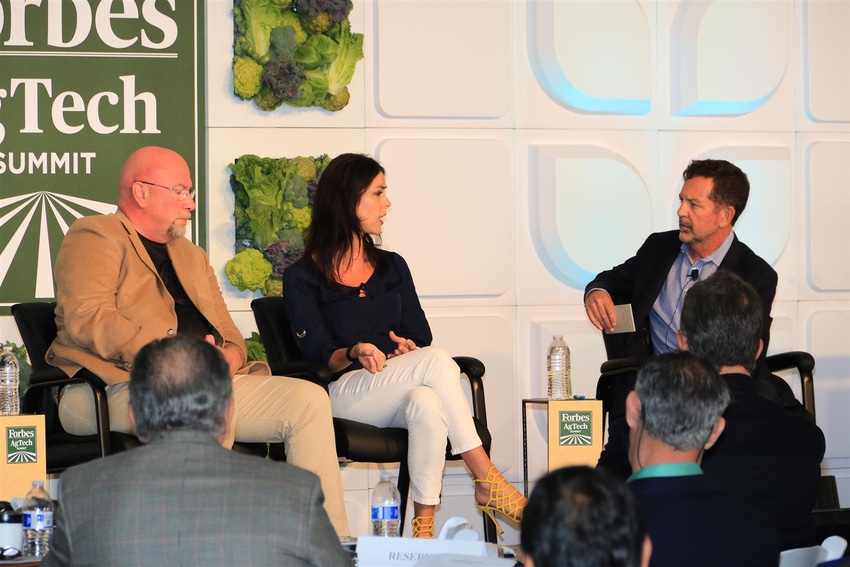
The message to high tech entrepreneurs at the recent Forbes AgTech Summit was simple: move faster.
Julie Borlaug, associate director for external relations with the Texas A&M Norman Borlaug Institute, spurred an audience of inventors, growers, venture capitalists and others from the agriculture sector to more quickly “push the boundaries of innovation.”
Borlaug is the granddaughter of the late Nobel Laureate Norman Borlaug.
She shared at the Forbes AgTech Summit in Salinas in mid-July that agricultural innovation is the barrier to solving world hunger issues – something her grandfather worked tirelessly on during his lifetime.
It won’t be the availability of technology that hampers progress, Borlaug believes, but the attitudes, fears and beliefs that drive policy that could handcuff progress.
“We have a public that believes everything they see on social media,” she said.
Borlaug was on a panel which kicked off the summit which discussed the need to boost global food production 70 percent by 2050. The necessity is real as the United Nations predicts about 9.5 billion people on Planet Earth by then, or roughly two billion more than live here today.
The organization expects the world population to explode to 11.2 billion by the turn of the century.
“My grandfather’s most potent view of science was that man’s most advanced knowledge and technology should be used to battle hunger and poverty,” Borlaug said.
To get there, Borlaug says new economic policies must be included with technological advancements in agriculture. She added, without naming names, that some of the world’s non-governmental organizations need to be bypassed because they stand in the way of progress.
Borlaug asserts that much of the fear campaigns related to GMOs are possibly coming from (some) non-government organizations (NGO).
“We don’t need the NGOs. They’re blocking change,” Borlaug said.
“You cannot be anti-hunger and anti-innovation at the same time,” she continued. “If you are going to be anti-innovation you better have a solution for us.”
High on Borlaug’s list is the need to address misinformation and lies about GMOs (genetically modified organisms) and other technologies necessary to boost agricultural production efficiencies.
For instance, Borlaug sees a host of benefits coming out of gene editing technology, which she hopes could help people “get beyond the whole GMO debate.”
'Hybrid 3.0'
Borlaug had a plea for the audience: “Please never use the word ‘engineering’ or ‘modification’ again. Just call it something like ‘hybrid 3.0’ or something like that and then we’ll never have this debate again.”
Borlaug says the GMO debate is simply confusing people, causing for even more confusion in marketing.
“We have ‘vegan’ green beans, ‘gluten-free’ cranberries, and ‘GMO-free’ beef,” she said with a laugh. “There is no such thing as GMO-beef.”
“We even have GMO-free salt sold at the stores. I like that one,” she said sarcastically.
Borlaug told a story of a Texas cattle company that proudly said it did not genetically modify its cattle. She approached the owner and said “of course you don’t. Do you mean you’re not getting feed that has been genetically modified, and he said ‘no, we do that; we just don’t genetically modify our cattle’.”
Borlaug also referenced the battle against the citrus disease Huanglongbing, or citrus greening, in Florida and Texas and its devastating impacts on the U.S. citrus industry.
“A researcher at Texas A&M is doing work to address citrus greening by inserting a spinach gene into citrus because spinach is resistant to greening disease,” she said.
Even as agriculture faces its challenges, Borlaug believes, “There’s a lot to be excited about” when it comes to agricultural technology. If we try to ban the future of agricultural innovation it’s just going to happen somewhere else,” she said.
Other needs
Dan Hodgson is the chief executive officer and president of Farm QA, a firm that uses communications devices and a cloud-based suite of integrated capabilities to help farmers manage what they can through sensors.
Hodgson believes that raising food from start to finish could become “significantly more profitable in the future” with the addition of sensors and software.
Water Updates
Get irrigation tips and news plus information about rainfall and drought predictions for Western United States farmers.
Of the challenges faced by farmers around the globe, one of them is in the assumption of technology and how challenges are addressed. It needs to be viewed in steps, he says, addressing one problem at a time, rather than trying to solve multiple challenges at once.
Further when Hodgson talks to farmers in California and the Midwest he’s told that Silicon Valley-type technology is not seen. The idea remains that the high tech firms of the Silicon Valley never venture beyond the Bay Area to talk with farmers, whether that be in the Salinas Valley, Central Valley or elsewhere in the United States.
Borlaug addressed the same issue from her global travels.
“You can go see it for yourself,” she said. “African farmers are basically farming like we were in the 1800s. It’s horrific that we’re allowing this to happen.”
High Tech Incubator
Overcoming that lack of communication between growers and the high tech world is the goal of Western Growers Association (WGA) and its new Center for Innovation and Technology.
As the Forbes summit was getting under way,the WGA technology center in Salinas was welcoming its 20th member. According to Hank Giclas, WGA senior vice president for strategic planning, science and technology, the incubator is designed to work with up to 36 companies.
Salinas Mayor Joe Gunter says the location of the WGA center is in line with the city’s goal as the high tech capital of the agricultural world.
“It just makes sense that we do this year because of our agricultural base and proximity to the Silicon Valley,” Gunter said.
About the Author(s)
You May Also Like






